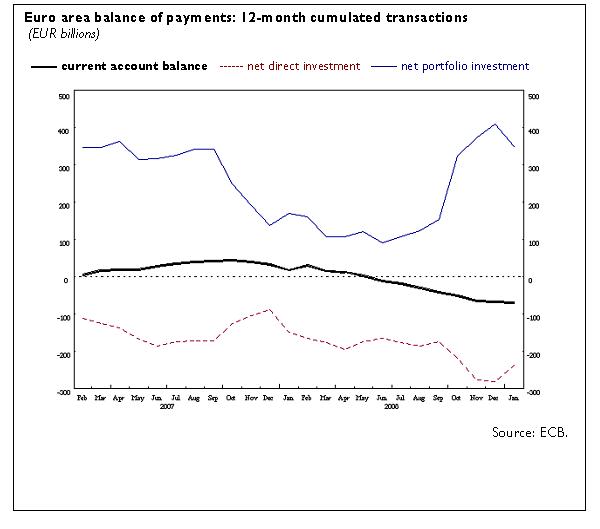Euro area balance of payments (January 2009)
In January 2009 the working day and seasonally adjusted current account of the euro area recorded a deficit of EUR 12.7 billion. In the financial account, combined direct and portfolio investment showed net outflows of EUR 23 billion.
Current account
The working day and seasonally adjusted current account of the euro area recorded a deficit of EUR 12.7 billion in January 2009 (corresponding to a deficit of EUR 18.2 billion in non-adjusted terms). This reflected deficits in current transfers (EUR 10.8 billion), income (EUR 4.2 billion) and goods (EUR 2.3 billion), which were only partly offset by a surplus in services (EUR 4.6 billion).
The 12-month cumulated, working day-adjusted current account up to January 2009 recorded a deficit of EUR 73.9 billion (about 0.8% of euro area GDP), compared with a surplus of EUR 17.0 billion a year earlier. This change was due mainly to shifts in the goods and income accounts from surplus (EUR 49.5 billion and EUR 5.3 billion respectively) to deficit (EUR 6.6 billion and EUR 23.1 billion).

Financial account
In the financial account, combined direct and portfolio investment showed net outflows of EUR 23 billion in January 2009, reflecting net outflows both in direct investment (EUR 20 billion) and in portfolio investment (EUR 3 billion).
The net outflows in direct investment resulted from net outflows in both equity capital and reinvested earnings (EUR 16 billion) and other capital (mostly inter-company loans) (EUR 3 billion).
Portfolio investment recorded net outflows in equity (EUR 52 billion) – reflecting net sales of euro area equity securities by non-residents – that were to a large extent offset by net inflows in debt instruments (EUR 48 billion), reflecting net purchases of euro area debt instruments by non-residents.
Financial derivatives recorded net inflows of EUR 6 billion.
Other investment recorded net inflows of EUR 66 billion, as a result of net inflows in MFIs, excluding the Eurosystem (EUR 152 billion) that were partly counterbalanced by net outflows from the Eurosystem (EUR 57 billion), other sectors (EUR 19 billion) and general government (EUR 11 billion). The net outflows from the Eurosystem were mainly related to the reciprocal currency arrangements (swap lines) between the European Central Bank (ECB) and central banks outside the euro area. The counterpart of these net outflows is the net inflows in MFIs excluding the Eurosystem, which resulted in an increase in euro area short-term liabilities.
Reserve assets decreased by EUR 5 billion (excluding valuation effects). The stock of the Eurosystem’s reserve assets stood at EUR 410 billion at the end of January 2009.
In the 12-month period to January 2009 combined direct and portfolio investment showed cumulated net inflows of EUR 111 billion, compared with net inflows of EUR 20 billion a year earlier. This increase resulted mainly from a rise in net inflows in portfolio investment (from EUR 168 billion to EUR 347 billion), which largely reflected higher net inflows in money market instruments. The increase in net inflows in portfolio investment was to a certain extent offset by higher net outflows in direct investment (up from EUR 148 billion to EUR 237 billion).
The inclusion of Slovakia in euro area external statistics
When Slovakia adopted the euro on 1 January 2009, its economic agents became euro area residents. Thus, for the first time, this press release shows a consistent time series for the balance of payments of the enlarged euro area, also including the periods before 2009. For the earlier data, the changes to the euro area external statistics involve: (i) the inclusion of transactions between residents in Slovakia and non-euro area residents; and (ii) the exclusion of transactions between euro area residents and residents in Slovakia. In addition, the related international investment position statistics have been recalculated to take into account the enlargement of the euro area (available on the ECB’s website). With the accession of Slovakia, the working day-adjusted euro area current account deficit for 2008 has increased by EUR 7.5 billion (about 0.1% of euro area GDP), mainly owing to the impact on the goods account. Net inflows in the euro area financial account have increased by EUR 8.2 billion
Additional information on the euro area balance of payments and international investment position
A complete set of updated euro area balance of payments and international investment position statistics is available on the ECB’s website in the “Statistics” section under the headings “Data services”/“Latest monetary, financial markets and balance of payments statistics”. These data, as well as the historical euro area balance of payments time series, can be downloaded from the ECB’s Statistical Data Warehouse (SDW). Data up to January 2009 will also be published in the April 2009 issues of the ECB’s Monthly Bulletin and Statistics Pocket Book. A detailed methodological note is available on the ECB’s website. The next press release on the euro area monthly balance of payments will be published on 23 April 2009.
Annexes
Table 1: Current account of the euro area – working day and seasonally adjusted data.
Table 2: Monthly balance of payments of the euro area – non-seasonally adjusted data.
Banco Central Europeu
Direção-Geral de Comunicação
- Sonnemannstrasse 20
- 60314 Frankfurt am Main, Alemanha
- +49 69 1344 7455
- media@ecb.europa.eu
A reprodução é permitida, desde que a fonte esteja identificada.
Contactos de imprensa

